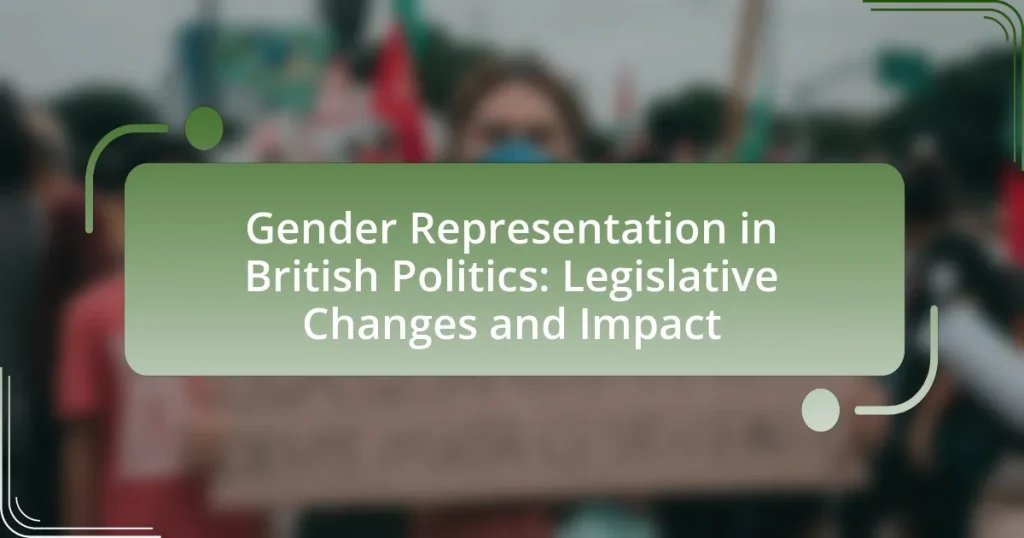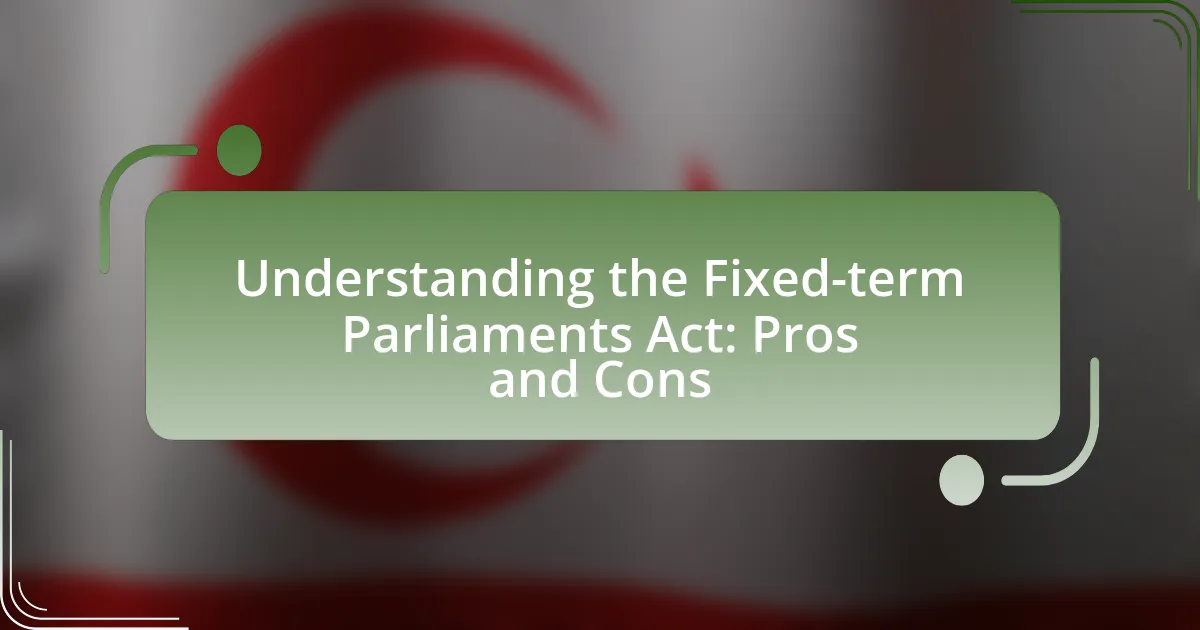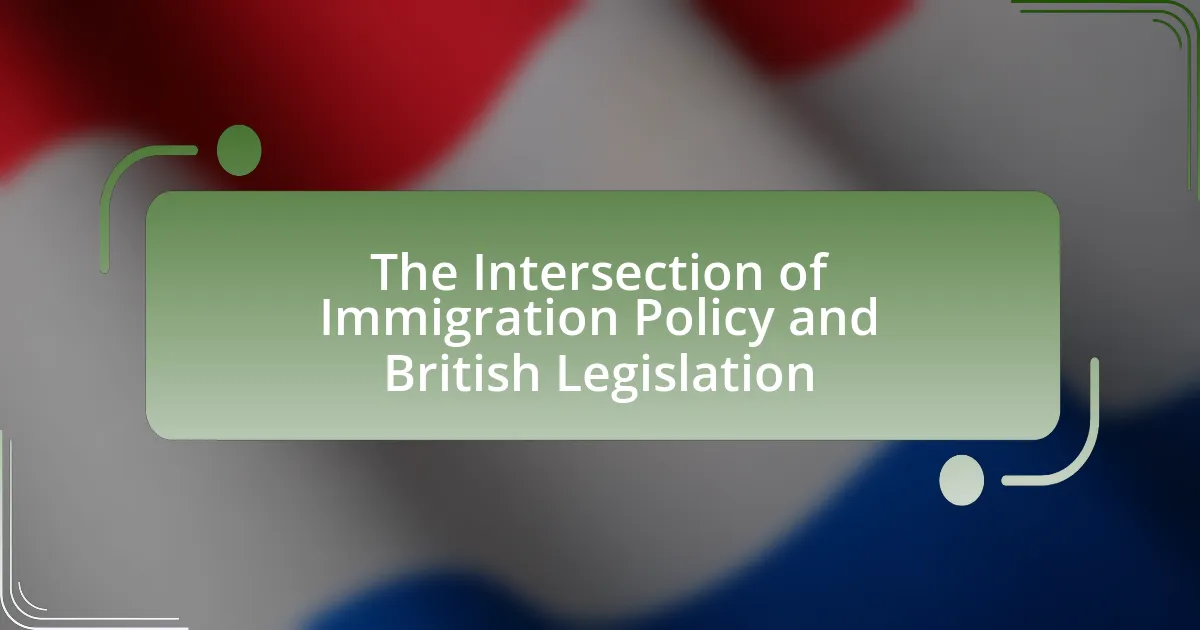Gender representation in British politics refers to the proportion of men and women in political roles, particularly in elected offices like the House of Commons, where women currently hold about 34% of seats. This article examines the importance of gender representation in ensuring diverse perspectives in policymaking, the historical trends and legislative changes that have influenced women’s participation, and the ongoing challenges faced by women in politics, including systemic biases and cultural stereotypes. It also explores the impact of gender representation on governance, public trust, and policy effectiveness, while highlighting successful strategies and best practices from other countries to enhance female representation in British politics.
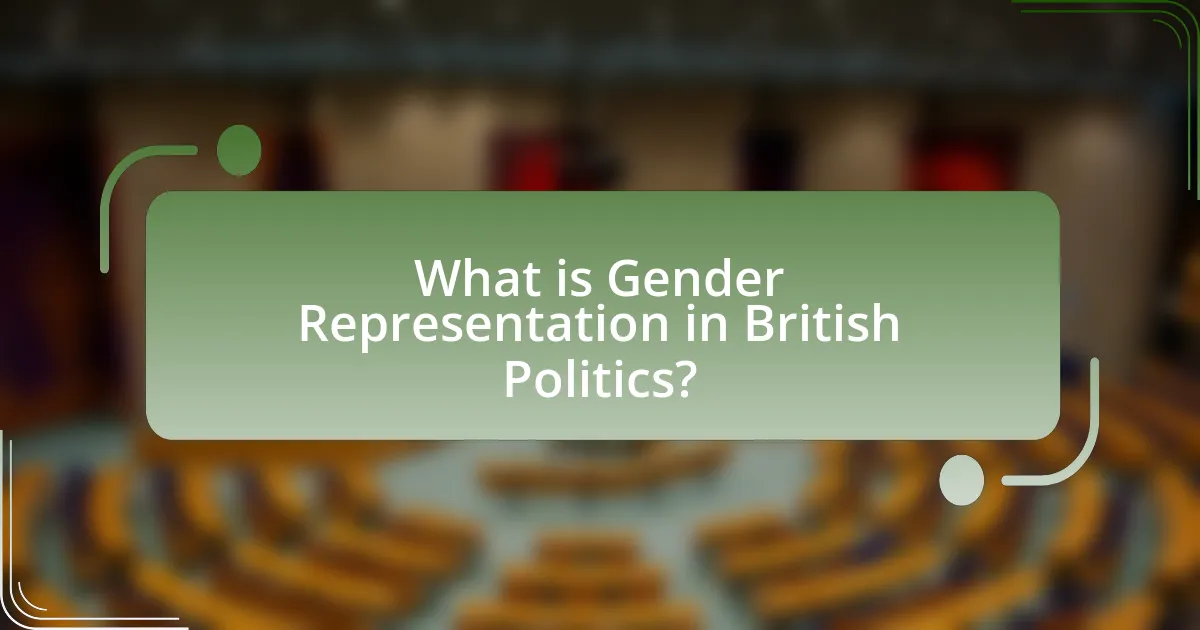
What is Gender Representation in British Politics?
Gender representation in British politics refers to the proportion of men and women in political positions, including elected offices and legislative bodies. As of 2023, women hold approximately 34% of the seats in the House of Commons, a significant increase from 18% in 1997, reflecting ongoing efforts to improve gender parity through initiatives such as all-women shortlists and gender quotas. This representation is crucial for ensuring diverse perspectives in policymaking and addressing issues that affect different genders.
Why is Gender Representation important in Politics?
Gender representation is important in politics because it ensures that diverse perspectives and experiences are included in decision-making processes. When women and marginalized genders participate in politics, policies are more likely to address the needs of the entire population rather than just a select group. Research shows that countries with higher levels of gender representation in legislative bodies, such as Rwanda, which has the highest percentage of women in parliament at over 60%, tend to have more progressive policies on health, education, and social welfare. This correlation highlights the impact of gender diversity on effective governance and societal well-being.
How does Gender Representation influence policy-making?
Gender representation significantly influences policy-making by ensuring diverse perspectives are included in the legislative process. When women and other underrepresented groups participate in politics, they advocate for issues that may be overlooked, such as reproductive rights, childcare, and gender-based violence. Research indicates that countries with higher levels of female representation in government, such as Rwanda, have implemented more progressive policies related to gender equality and social welfare. This correlation demonstrates that increased gender representation leads to more comprehensive and inclusive policy outcomes, ultimately benefiting society as a whole.
What are the historical trends in Gender Representation in British Politics?
Historical trends in gender representation in British politics show a gradual increase in women’s participation over the past century. In 1918, women gained the right to vote in parliamentary elections, marking a significant milestone. By 1979, Margaret Thatcher became the first female Prime Minister, highlighting women’s ascent to high political office. As of 2021, women constituted approximately 34% of Members of Parliament, reflecting ongoing efforts to improve gender balance. The introduction of measures such as all-women shortlists by the Labour Party in the 1990s further accelerated female representation, demonstrating a commitment to addressing gender disparities in political roles.
What are the key legislative changes affecting Gender Representation?
Key legislative changes affecting gender representation in British politics include the Equality Act 2010, which consolidated previous anti-discrimination laws and mandated equal treatment in various sectors, including politics. Additionally, the Representation of the People Act 1985 and subsequent amendments aimed to enhance the representation of women by allowing political parties to adopt all-women shortlists, which has significantly increased female candidates in elections. The Gender Equality Duty introduced in 2007 required public authorities to actively promote gender equality, further influencing political representation. These legislative measures collectively aim to address gender disparities and promote equal representation in political offices.
Which laws have been enacted to promote Gender Representation?
The Equality Act 2010 is a significant law enacted in the UK to promote gender representation. This legislation consolidates various anti-discrimination laws and mandates equal treatment in various areas, including employment and public services. Additionally, the Representation of the People Act 1985 introduced measures to ensure that political parties adopt practices that promote gender equality in candidate selection. These laws collectively aim to enhance women’s representation in political and public life, contributing to a more balanced and equitable society.
How have these legislative changes impacted political participation?
Legislative changes aimed at improving gender representation in British politics have significantly increased political participation among women. For instance, the introduction of the Gender Equality Duty in 2007 mandated public authorities to promote gender equality, resulting in a notable rise in the number of women candidates and elected officials. According to the House of Commons Library, the proportion of female MPs increased from 18% in 2005 to 32% in 2019, demonstrating a direct correlation between these legislative measures and enhanced female political engagement.
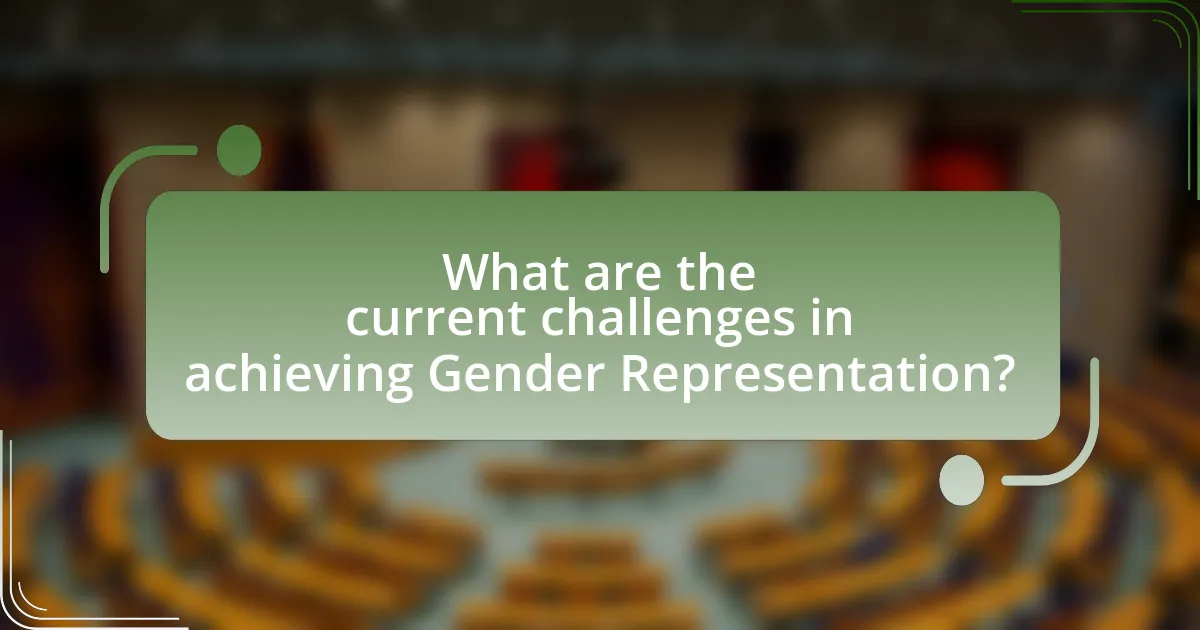
What are the current challenges in achieving Gender Representation?
Current challenges in achieving gender representation include systemic biases, cultural stereotypes, and structural barriers within political institutions. Systemic biases manifest in the underrepresentation of women in leadership roles, with women holding only 34% of seats in the UK Parliament as of 2023. Cultural stereotypes often discourage women from pursuing political careers, perpetuating the notion that leadership is a male domain. Additionally, structural barriers such as lack of access to funding, mentorship, and networks further hinder women’s participation in politics. These factors collectively contribute to the ongoing struggle for equitable gender representation in British politics.
What barriers do women face in British Politics?
Women in British politics face several barriers, including systemic sexism, underrepresentation in leadership roles, and challenges related to work-life balance. Systemic sexism manifests in gender biases that affect women’s credibility and authority, often leading to their ideas being undervalued. Underrepresentation is evident, as women hold only about 34% of seats in the House of Commons, which limits their influence on policy-making. Additionally, the demanding nature of political careers often conflicts with family responsibilities, making it difficult for women to pursue or sustain political roles. These barriers collectively hinder women’s full participation and representation in British politics.
How do societal attitudes affect women’s political participation?
Societal attitudes significantly influence women’s political participation by shaping perceptions of gender roles and expectations. When societies hold traditional views that prioritize male leadership, women may face barriers such as discrimination, lack of support, and reduced confidence in their political capabilities. For instance, research by the Inter-Parliamentary Union indicates that countries with more progressive gender norms tend to have higher percentages of women in political office, demonstrating a direct correlation between societal attitudes and women’s representation. Additionally, studies show that positive media portrayals of female politicians can enhance public support for women in politics, further illustrating how societal perceptions can either facilitate or hinder women’s political engagement.
What role do political parties play in Gender Representation?
Political parties play a crucial role in gender representation by determining candidate selection, policy priorities, and party culture. They influence the number of women and marginalized genders in political positions through mechanisms such as quotas, which have been adopted by various parties to ensure a minimum representation. For instance, the Labour Party in the UK implemented all-women shortlists in certain constituencies, significantly increasing female representation in Parliament. Additionally, political parties shape public discourse around gender issues, impacting legislative agendas and societal norms. The presence of women in leadership roles within parties also serves as a model for aspiring female politicians, further promoting gender equity in politics.
How does intersectionality affect Gender Representation in Politics?
Intersectionality significantly affects gender representation in politics by highlighting how overlapping social identities, such as race, class, and sexuality, influence individuals’ political experiences and opportunities. This framework reveals that women from marginalized backgrounds often face compounded barriers to political participation, which can lead to underrepresentation in legislative bodies. For instance, a study by the House of Commons Women and Equalities Committee in 2016 found that Black, Asian, and Minority Ethnic women are less likely to be selected as candidates for political office compared to their white counterparts, illustrating the impact of intersectionality on political representation.
What are the experiences of women from diverse backgrounds in British Politics?
Women from diverse backgrounds in British politics often face unique challenges, including systemic barriers, underrepresentation, and intersectional discrimination. Research indicates that women of color and those from lower socioeconomic backgrounds encounter additional hurdles compared to their white counterparts, such as biases in party selection processes and limited access to networks. For instance, a report by the Fawcett Society highlights that only 3% of Members of Parliament are women of color, reflecting significant disparities in representation. Furthermore, the experiences of these women are shaped by cultural expectations and societal norms, which can influence their political engagement and career progression. This context underscores the need for targeted initiatives to enhance diversity and inclusion within political institutions in the UK.
How can policies address intersectional challenges in representation?
Policies can address intersectional challenges in representation by implementing targeted measures that promote inclusivity across various demographics. For instance, the introduction of quotas for underrepresented groups in political positions can ensure that diverse voices are included in decision-making processes. Research by the House of Commons Library indicates that gender quotas have led to increased female representation in Parliament, demonstrating the effectiveness of such policies. Additionally, intersectional training programs for policymakers can enhance awareness of the unique challenges faced by individuals at the intersection of multiple identities, fostering a more equitable political environment.
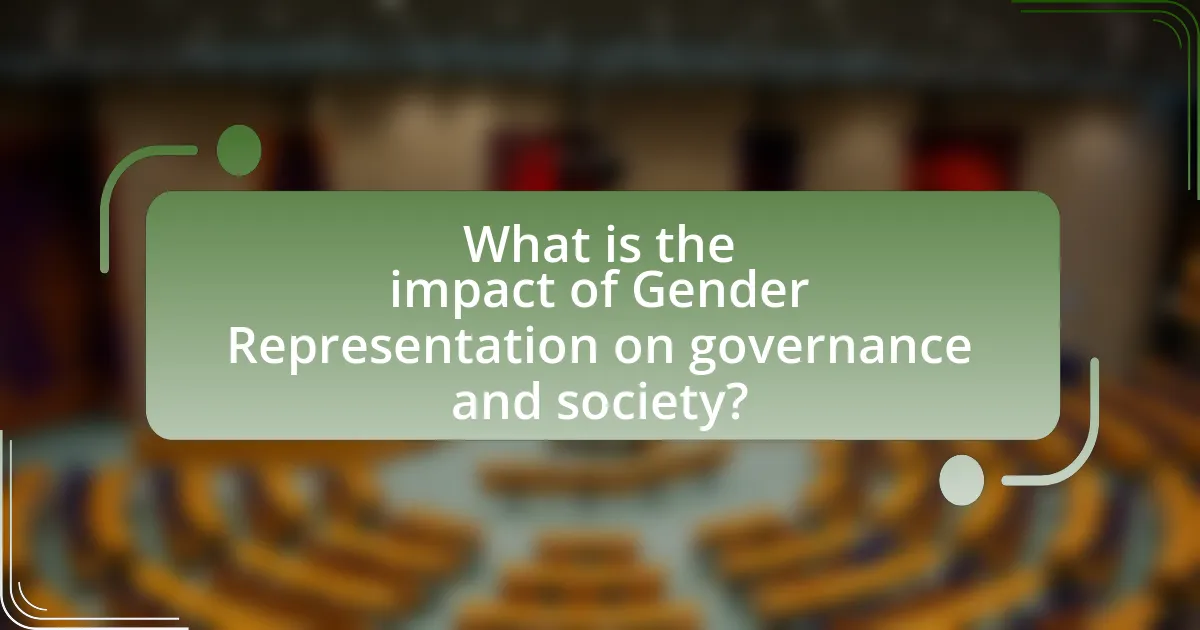
What is the impact of Gender Representation on governance and society?
Gender representation significantly enhances governance and societal outcomes by promoting diverse perspectives and equitable decision-making. Research indicates that increased female representation in political offices correlates with more comprehensive policy agendas that address issues such as healthcare, education, and social welfare, which are often prioritized by women. For instance, a study by the Inter-Parliamentary Union found that countries with higher percentages of women in parliament tend to have more progressive legislation on gender equality and family policies. Furthermore, gender-diverse leadership fosters greater public trust and engagement, as it reflects the demographics of the population, leading to more inclusive governance.
How does Gender Representation affect legislative outcomes?
Gender representation significantly affects legislative outcomes by influencing the types of policies that are prioritized and the perspectives that are included in the legislative process. Research indicates that increased female representation in legislatures leads to a greater focus on issues such as healthcare, education, and social welfare, which are often underrepresented in male-dominated settings. For instance, a study by the Inter-Parliamentary Union found that countries with higher percentages of women in parliament are more likely to pass laws promoting gender equality and family welfare. This correlation suggests that diverse representation can lead to more comprehensive and inclusive policymaking, ultimately shaping legislative agendas to better reflect the needs of the entire population.
What evidence exists linking Gender Representation to policy effectiveness?
Evidence linking gender representation to policy effectiveness includes studies showing that increased female representation in legislative bodies leads to more comprehensive and inclusive policy outcomes. For instance, research by the Inter-Parliamentary Union indicates that countries with higher percentages of women in parliament tend to prioritize issues such as healthcare, education, and gender equality, resulting in policies that better reflect the needs of diverse populations. Additionally, a study published in the American Economic Journal found that women legislators are more likely to advocate for social welfare policies, which can lead to improved social outcomes. These findings demonstrate a clear correlation between gender representation and the effectiveness of policies in addressing the needs of the community.
How does Gender Representation influence public trust in government?
Gender representation significantly influences public trust in government by enhancing perceptions of legitimacy and inclusivity. When women and diverse gender identities are represented in political offices, it fosters a sense of belonging among constituents, leading to increased trust in governmental institutions. Research indicates that countries with higher levels of female representation, such as Rwanda, which has the highest percentage of women in parliament globally at over 60%, often report greater public trust in government. This correlation suggests that diverse representation can improve governance outcomes and public satisfaction, as it reflects the demographics and needs of the population more accurately.
What best practices can enhance Gender Representation in British Politics?
Implementing gender quotas is a best practice that can significantly enhance gender representation in British politics. Gender quotas, which require a certain percentage of candidates to be women, have been shown to increase female participation in political offices. For instance, countries like Norway and Rwanda have successfully utilized gender quotas, resulting in women holding over 40% of parliamentary seats in Norway and more than 60% in Rwanda. Additionally, providing targeted training and mentorship programs for women aspiring to enter politics can empower them and improve their chances of success. Research from the University of Exeter indicates that mentorship initiatives can lead to increased confidence and political engagement among women. Furthermore, promoting flexible working arrangements and family-friendly policies within political parties can help create an environment that supports women in balancing political careers with family responsibilities, thereby encouraging more women to participate in politics.
What strategies have been successful in other countries?
Countries such as Rwanda and Sweden have successfully implemented gender quotas to enhance female representation in politics. Rwanda, after the 1994 genocide, adopted a constitutional mandate requiring at least 30% of parliamentary seats to be held by women, resulting in women holding over 60% of seats in the lower house as of 2021. Sweden has employed a voluntary party quota system, where political parties set internal targets for female candidates, leading to women comprising approximately 47% of the Swedish parliament. These strategies demonstrate that legislative measures and party-level commitments can significantly improve gender representation in political institutions.
How can political parties implement effective gender quotas?
Political parties can implement effective gender quotas by establishing clear numerical targets for female representation within their candidate selection processes. For instance, the Labour Party in the UK adopted all-women shortlists in 1997, which significantly increased the number of women elected to Parliament, demonstrating that structured quotas can lead to tangible outcomes. Additionally, parties should ensure that these quotas are accompanied by supportive measures, such as training programs for female candidates and mentorship initiatives, to enhance their competitiveness. Research indicates that political parties with gender quotas tend to have higher female representation, as seen in countries like Sweden, where a 50% quota led to women holding 47% of parliamentary seats by 2018.
